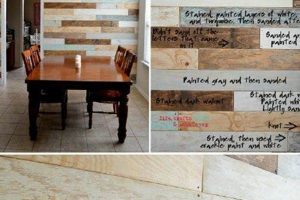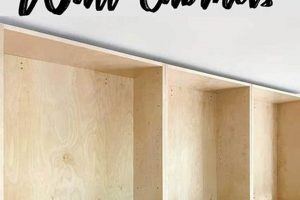The construction of homemade bicycle storage solutions affixed to vertical surfaces enables the efficient organization of bikes within a limited space. These projects frequently involve the utilization of readily available materials and basic tools to create a secure and accessible location for suspending bicycles. An example includes repurposing wooden planks and metal hooks to fashion a simple yet functional rack.
Such installations offer numerous advantages, particularly in apartments, garages, or small homes where floor space is at a premium. By elevating bicycles, these structures minimize clutter, protect the bikes from potential damage, and enhance the overall aesthetic of the storage area. Furthermore, this approach provides an economical alternative to commercially manufactured options, often allowing for customization based on specific needs and preferences. This method has become increasingly popular as cycling grows in urban environments and individuals seek practical and cost-effective storage solutions.
The following sections will delve into various design approaches, material considerations, essential tools, step-by-step instructions, and safety precautions relevant to creating effective and reliable bicycle storage fixtures of this type.
Essential Considerations for Homemade Bicycle Wall Supports
The construction of a secure and functional bicycle wall support requires careful planning and execution. The following tips address key aspects of the design and installation process to ensure both the bicycle’s safety and the longevity of the support structure.
Tip 1: Assess Wall Structure: Prior to initiating construction, determine the composition of the wall. Concrete, brick, or stud-framed walls each necessitate different anchoring methods. For stud walls, locate studs using a stud finder and ensure the mount is securely fastened to the center of the stud for optimal load-bearing capacity.
Tip 2: Choose Appropriate Materials: Select materials based on the bicycle’s weight and the intended aesthetic. Solid wood, such as oak or maple, provides substantial strength and durability. Steel or aluminum components offer lightweight alternatives. Ensure all hardware, including screws and bolts, is rated for the anticipated load.
Tip 3: Prioritize Bicycle Protection: Incorporate padding or protective coverings on contact points to prevent scratches or damage to the bicycle frame. Felt, rubber, or specialized frame protectors can mitigate potential abrasion.
Tip 4: Precise Measurement and Leveling: Accurate measurements are crucial for ensuring the bicycle hangs level and securely. Utilize a level during installation to guarantee proper alignment and prevent uneven weight distribution, which can compromise the structure’s integrity.
Tip 5: Secure Anchoring Techniques: Implement appropriate anchoring methods based on the wall type. Concrete or brick walls require expansion anchors, while stud walls benefit from lag screws or heavy-duty wood screws driven directly into the stud.
Tip 6: Weight Distribution Analysis: Consider the bicycle’s center of gravity when designing the support. Distribute the weight evenly across multiple attachment points to reduce stress on individual components and enhance overall stability.
Tip 7: Regular Inspection and Maintenance: Periodically inspect the support for signs of wear or damage, such as loose screws or cracks in the wood. Tighten any loose hardware and replace any damaged components promptly to maintain the structure’s integrity.
Effective implementation of these considerations will result in a robust and dependable bicycle wall support, providing a secure and space-saving storage solution.
The following sections will expand on specific design options and provide detailed instructions for creating a custom bicycle storage fixture.
1. Wall Material Assessment
Wall material assessment represents a foundational element in the successful execution of a homemade bicycle storage solution affixed to a vertical surface. The structural composition of the wallwhether concrete, brick, wood stud, or drywalldirectly dictates the appropriate anchoring methods and hardware required to safely support the weight of the bicycle. Failure to accurately assess the wall’s material can result in catastrophic consequences, including mount failure, bicycle damage, and potential injury.
For instance, attempting to secure a bicycle mount solely to drywall without utilizing appropriate anchors or reinforcement will inevitably lead to pull-out, as drywall lacks the necessary load-bearing capacity. Conversely, using wood screws directly into concrete or brick will prove ineffective, as these materials require expansion anchors that grip through compression. A real-world example involves a homeowner who, without properly assessing the wall, installed a mount using drywall anchors, resulting in the bicycle falling and causing significant damage to both the bicycle and the wall. This highlights the practical significance of understanding wall composition before commencing installation.
Therefore, thorough assessment of wall materials is not merely a preliminary step but an imperative one. By correctly identifying the wall’s composition, appropriate anchoring methods can be selected, ensuring a secure and reliable bicycle storage solution. The absence of such assessment introduces unacceptable risks, undermining the integrity and safety of the entire installation. Furthermore, recognizing the limitations of certain wall types allows for informed decisions regarding weight limits and alternative mounting strategies, if necessary.
2. Mounting Hardware Selection
Mounting hardware selection represents a critical juncture in the creation of a secure and functional bicycle storage system affixed to a vertical surface. The inappropriate selection or utilization of hardware can compromise the integrity of the installation, leading to potential bicycle damage or personal injury. Therefore, a thorough understanding of various hardware options and their respective applications is paramount.
- Anchor Type and Wall Compatibility
The selection of anchor type must directly correspond to the wall material. Concrete or brick walls necessitate expansion anchors, sleeve anchors, or wedge anchors capable of gripping the masonry. Wood stud walls typically require lag screws or heavy-duty wood screws that can penetrate the stud’s center. Drywall, lacking inherent structural integrity, demands specialized drywall anchors designed to distribute the load. The use of an inappropriate anchor, such as a drywall anchor in concrete, will result in failure.
- Load Rating and Safety Margin
Each piece of hardware possesses a specified load rating, representing the maximum weight it can safely support. It is imperative to select hardware with a load rating that exceeds the weight of the bicycle by a significant margin, typically a factor of safety of at least two. This safety margin accounts for dynamic loads, vibrations, and potential material fatigue. Failure to adhere to this principle can lead to catastrophic failure, particularly under prolonged stress.
- Material Durability and Corrosion Resistance
The material composition of the hardware influences its durability and resistance to corrosion. Galvanized steel offers a balance of strength and corrosion resistance suitable for indoor environments. Stainless steel provides superior corrosion resistance, making it ideal for damp or outdoor applications. Brass hardware, while aesthetically pleasing, may not possess the same load-bearing capacity as steel. Selection of hardware based on environmental factors contributes to the long-term reliability of the bicycle storage fixture.
- Hardware Dimensions and Compatibility
The dimensions of the hardware, including screw length, bolt diameter, and anchor size, must be carefully considered in relation to the thickness of the mounting surface and the design of the bicycle mount. Insufficient screw length will result in inadequate penetration and reduced holding power. Conversely, excessive screw length can protrude through the wall, posing a safety hazard. Selecting hardware with compatible dimensions ensures a secure and flush fit, maximizing the structural integrity of the installation.
The interconnectedness of these facets underscores the complexity of hardware selection. By meticulously considering wall material, load rating, material durability, and hardware dimensions, individuals can create bicycle storage solutions that are both structurally sound and aesthetically pleasing. The diligent application of these principles minimizes risk and maximizes the longevity of the homemade structure.
3. Weight Load Calculation
Weight load calculation is an indispensable element in the successful and safe construction of a bicycle storage fixture affixed to a vertical surface. It represents a systematic process of determining the maximum weight the structure will bear, encompassing not only the bicycle’s static weight but also potential dynamic forces induced by movement or vibrations. An inaccurate weight load calculation introduces the risk of structural failure, leading to property damage and potential physical harm. For instance, if a bicycle weighing 30 pounds is mounted on a structure designed to support only 20 pounds, the mounting hardware or the structure itself may fail, causing the bicycle to fall.
The calculation process involves considering several factors. The bicycle’s weight must be determined accurately, preferably using a calibrated scale. The type of mounting hardware, including anchors and screws, must be selected with load ratings that significantly exceed the bicycle’s weight, typically by a safety factor of two or more. The wall material’s load-bearing capacity also plays a crucial role, as different materials (e.g., concrete, wood studs, drywall) offer varying levels of support. Moreover, consideration should be given to the distribution of weight across multiple mounting points, as uneven distribution can concentrate stress on individual components. A practical example of this is seen when constructing a horizontal bike rack with two support arms; distributing the bike’s weight evenly between the two arms is critical for preventing overstress on either arm or its corresponding wall anchors.
In summary, weight load calculation is not merely an academic exercise but a practical necessity. Accurate calculation, coupled with the selection of appropriate materials and hardware, ensures the structural integrity and long-term safety of the bicycle storage fixture. Neglecting this crucial step introduces unacceptable risks and undermines the overall reliability of the system. The inherent challenges in estimating dynamic forces necessitate the application of conservative safety factors, highlighting the importance of rigorous planning and execution. This understanding contributes to the broader goal of creating effective and dependable bicycle storage solutions, mitigating potential hazards and enhancing the functionality of the storage space.
4. Bicycle Frame Protection
The implementation of adequate safeguarding measures for bicycle frames represents a fundamental aspect of designing and constructing secure storage solutions that are affixed to vertical surfaces. The risk of damage, abrasion, or deformation to the bicycle frame necessitates proactive consideration of protection methods during the design and construction phases. Neglecting these measures can result in cosmetic imperfections or, more seriously, structural compromise of the bicycle frame.
- Padding Material Selection
The selection of appropriate padding materials is paramount for preventing direct contact between the bicycle frame and the storage fixture. Materials such as closed-cell foam, rubber, or felt offer varying degrees of cushioning and abrasion resistance. For instance, wrapping the support arms of a wall-mounted rack with closed-cell foam can effectively mitigate scratches and dings caused by repeated mounting and dismounting of the bicycle. Conversely, the use of abrasive materials or sharp edges in the absence of padding can lead to significant paint damage or even gouging of the frame. The choice of padding should be based on the frame material (e.g., carbon fiber, aluminum, steel) and the anticipated frequency of use.
- Contact Point Design
The design of the contact points between the bicycle frame and the storage fixture plays a crucial role in distributing weight and minimizing stress concentration. Wide, flat contact surfaces are generally preferable to narrow or pointed surfaces, as they distribute the load more evenly. Incorporating curved or contoured surfaces that conform to the shape of the bicycle frame can further reduce stress points. A practical example is the use of U-shaped supports lined with padding to cradle the bicycle frame, preventing localized pressure that could lead to deformation, particularly in lightweight or thin-walled frames.
- Frame Geometry Considerations
Different bicycle frame geometries necessitate customized protection strategies. Mountain bikes with sloping top tubes and complex suspension linkages require different support configurations than road bikes with traditional horizontal top tubes. The design of the storage fixture should accommodate the specific frame geometry to ensure secure and stable support without placing undue stress on vulnerable areas. For example, a wall-mounted rack designed for a road bike might not be suitable for a mountain bike with a significantly different frame shape, potentially leading to instability and increased risk of damage.
- Fastener Protrusion Prevention
Careful attention must be paid to the prevention of fastener protrusion, as exposed screw heads, bolt ends, or sharp edges can cause significant damage to the bicycle frame. Countersinking screws, using recessed fasteners, or covering exposed hardware with protective caps can effectively eliminate this risk. A common scenario involves the use of screws that are too long, protruding through the support structure and scratching the bicycle frame upon contact. Thorough planning and meticulous execution are essential for preventing such occurrences.
These facets, when integrated thoughtfully into the design and construction of a wall-mounted bicycle storage fixture, contribute significantly to the long-term preservation of the bicycle frame. The implementation of appropriate protection measures not only safeguards against cosmetic damage but also mitigates the risk of structural compromise, ensuring the continued functionality and value of the bicycle. This proactive approach reflects a commitment to both the bicycle’s well-being and the overall quality of the storage solution.
5. Spatial Optimization
Spatial optimization, in the context of constructing bicycle storage solutions affixed to vertical surfaces, directly addresses the efficient and effective utilization of available area. This optimization is a crucial consideration, particularly in confined spaces such as apartments, garages, or storage rooms, where maximizing usable square footage is paramount. The fundamental premise involves minimizing the bicycle’s footprint through vertical storage, thereby freeing up floor space for other purposes. A lack of spatial optimization results in a cluttered environment, potential safety hazards, and reduced accessibility to other items within the designated area. For example, a bicycle leaning against a wall consumes valuable floor space, impeding movement and limiting the storage of other objects. In contrast, a well-designed wall mount elevates the bicycle, reclaiming that floor space and improving overall organization.
The implementation of spatial optimization techniques necessitates careful planning and design considerations. This includes selecting appropriate mount types based on the bicycle’s geometry and the available wall space. Vertical mounts, for instance, suspend the bicycle vertically, minimizing its width and maximizing headroom. Horizontal mounts, on the other hand, present the bicycle parallel to the wall, reducing its depth but potentially increasing its width. The choice depends on the specific dimensions of the space and the orientation of the wall. Furthermore, the strategic placement of the mount relative to doorways, walkways, and other storage areas is critical for ensuring unobstructed access and preventing collisions. A real-world application involves a small apartment where a vertical mount is installed near a corner, allowing the bicycle to be stored out of the main traffic flow, thus optimizing the limited space.
In conclusion, spatial optimization is an intrinsic component of crafting efficient bicycle storage solutions, impacting both the functionality and aesthetic appeal of the storage area. Addressing the challenges associated with limited space requires a thoughtful approach, encompassing mount selection, placement strategy, and consideration of environmental factors. The successful integration of spatial optimization principles leads to a more organized, accessible, and visually appealing storage environment, directly contributing to the overall utility and satisfaction derived from the project. Understanding this relationship links directly to the broader theme of efficient resource management and the intelligent design of living and storage spaces.
Frequently Asked Questions
The following questions address common concerns and practical considerations regarding the construction and installation of bicycle storage solutions affixed to vertical surfaces.
Question 1: What is the minimum skill level required to construct a homemade bicycle wall mount?
A basic understanding of carpentry or metalworking is generally sufficient. Familiarity with hand tools, power drills, and measuring techniques is advantageous. More complex designs may necessitate advanced skills, such as welding or precise joinery.
Question 2: What are the potential risks associated with a poorly constructed bicycle wall mount?
A poorly constructed mount can lead to bicycle damage, wall damage, and potential injury. Structural failure can result in the bicycle falling, posing a hazard to individuals and property. Insufficient anchoring can compromise the mount’s stability, increasing the risk of accidents.
Question 3: How can the risk of scratching or damaging the bicycle frame be minimized?
Utilizing padded supports, such as foam or rubber, is crucial. Ensure all contact points between the bicycle frame and the mount are adequately cushioned. Avoid sharp edges or abrasive surfaces. Regular inspection and maintenance of the padding are recommended.
Question 4: What type of wall is most suitable for a homemade bicycle wall mount?
Concrete or solid wood stud walls are generally the most suitable due to their inherent structural strength. Drywall requires specialized anchors and may not be appropriate for heavier bicycles. Proper assessment of the wall’s composition is essential before installation.
Question 5: How frequently should a homemade bicycle wall mount be inspected for wear and tear?
A visual inspection should be conducted at least every three months. Check for loose screws, cracks, or any signs of structural degradation. Tighten any loose hardware and replace damaged components immediately. More frequent inspections may be necessary for mounts subjected to heavy use or environmental factors.
Question 6: Is it possible to adapt existing commercially available mounts for a DIY installation?
Yes, existing mounts can be modified for custom installations, provided that the modifications do not compromise the structural integrity of the mount. Ensure that any alterations are performed by a qualified individual and that the modified mount is thoroughly tested before use.
Proper planning, execution, and maintenance are essential for ensuring the safety and effectiveness of any bicycle storage fixture affixed to a vertical surface. Always prioritize safety and consult with qualified professionals when necessary.
The subsequent section explores specific design considerations for maximizing space and aesthetics within the designated storage area.
Conclusion
This exploration of constructing bicycle storage solutions affixed to vertical surfaces has underscored the critical elements involved in creating safe, efficient, and aesthetically pleasing installations. Emphasis has been placed on wall material assessment, mounting hardware selection, weight load calculation, bicycle frame protection, and spatial optimization, all of which are foundational to a successful project. The inherent risks associated with inadequate planning and execution have been highlighted to promote responsible construction practices.
The information presented serves as a guide for individuals seeking to implement such solutions. Diligent adherence to these principles ensures the creation of a secure and reliable system, contributing to the responsible management of space and the long-term preservation of equipment. Further research and consultation with qualified professionals are encouraged to tailor these concepts to specific needs and circumstances, ultimately enhancing the efficacy and safety of these projects.







